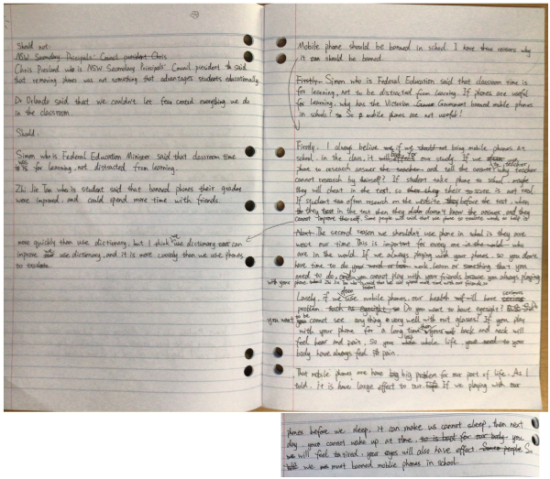Student information
The student is 14 years old and in Year 9. She comes from Hong Kong and speaks Cantonese as her home language. She has had age-equivalent schooling in her home country and is able to read and write in her home language. The student has been in Australia for three months and is studying at an English language school.
Task
This written task was part of a unit of work on current issues. Students had completed reading activities, learnt vocabulary related to the topic, and new grammatical structures such as relative clauses and reported speech. Then they completed a first draft on the topic Should mobile phones be banned in schools? Students were provided with a model text as an example to support their writing.

Text
Simon who is Federal Education said that classroom time is for learning, not to be distracted from learning. If phones are useful for learning, why has the Victorian govern Government banned mobile phones in schools?
so So mobile phones are not useful!
Mobile phone should be banned in school. I have three reasons why it
can should be banned.
Firstly, I always believe
we if we
should not bring mobile phones at school, in the class, it
will effect bad for our study. If we
often use phone to research answer
the teacher and tell the answer to teacher, why teacher cannot research by theirself? If student take phone to school, maybe they will cheat in the test, so
ther they their
so score is not real. If student
res often research on the website,
they before the test, when
the they
test in the test when they
didn doesn't know the answers. and they cannot improve theirself. Some people will said that use phone to translate words to help is more quickly than use dictionary, but I think we use dictionary
can can improve
our we use dictionary, and it is more correly than we use phones to traslate.
Next The second reason we shouldn't use phone in school is they are west our time. This is important for every one
in the world who are in the world. If we always playing with your phones, so you don't have time to do your
word or learn work, learn or something that you need to do.
and you cannot play with your friends becuase you always playing with your phone Zhi Jie Tan who is student said that he can spend more time with our friends so
Lastly, if we often use mobile phones, our health
if will have serious problems.
such as eyesight, so Do you want to have eyesight?
ASSD you want
you to be cannot see anything very well with out glasses? If you play with your phone for a long time then your
wil back and neck will feel hear and pain. So your
whole less whole life,
your need to your body have always feel
ill pain.
That mobile phones are have
big big problem for most part of life. As I told, it is have large effect to our
life. If we playing with our phones before we sleep, it can make us cannot sleep, then next day, your cannot wake up at time,
so is bad for our body you
we will feel
ta tired, your eyes will also have effect.
Some people So
We we must banned mobile phones in school.
This sample of student work demonstrates that the student can:
- Use mostly standard word order (VCEALL664)
- Write using a range of tenses with varied accuracy (VCEALL666)
- Link ideas using a range of basic cohesive devices (VCEALL663)
- Use adverbials to provide simple detail (VCEALL667)
Overall, this student can also:
- Write some creative or personal texts, experimenting with known English (VCEALC655)
- Spell most commonly encountered words correctly (VCEALL670)
Possible next steps for this student's learning
- Reviewing writing for present simple tense, in particular the verb to be (VCEALL666)
- Researching and selecting a range of evidence to support arguments (VCEALA656)
- Revising and reorganising the structure of the essay, with a focus on effective introductions and conclusions (VCEALL661)
- Learning how to use the first conditional, for example, If we bring phones to class, it will affect our study (VCEALL665)
Pathways and transitions considerations
A Year 9 student who is working within the range of Level C2 in any one language mode is not ready to transition to the English curriculum regardless of their proficiency in the other two language modes. This student will continue on Pathway C of the EAL curriculum.